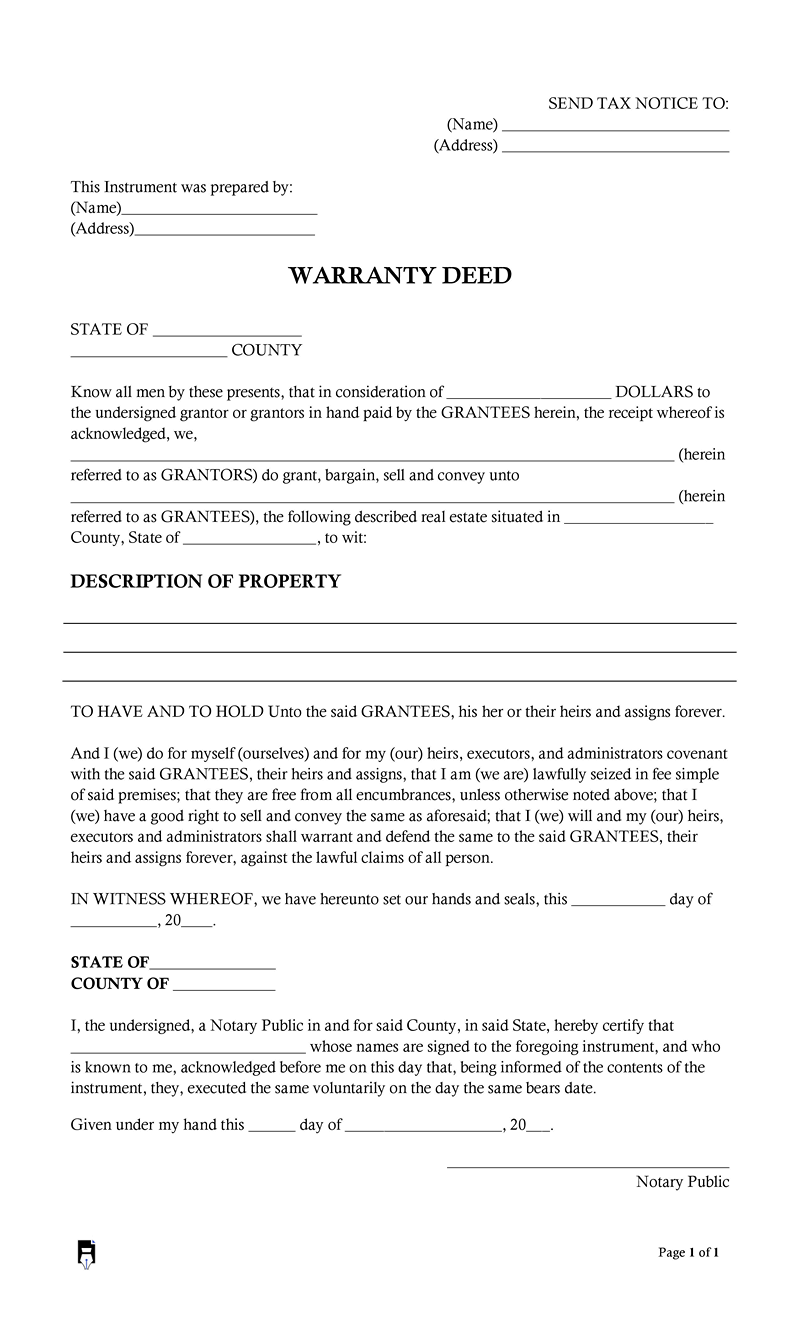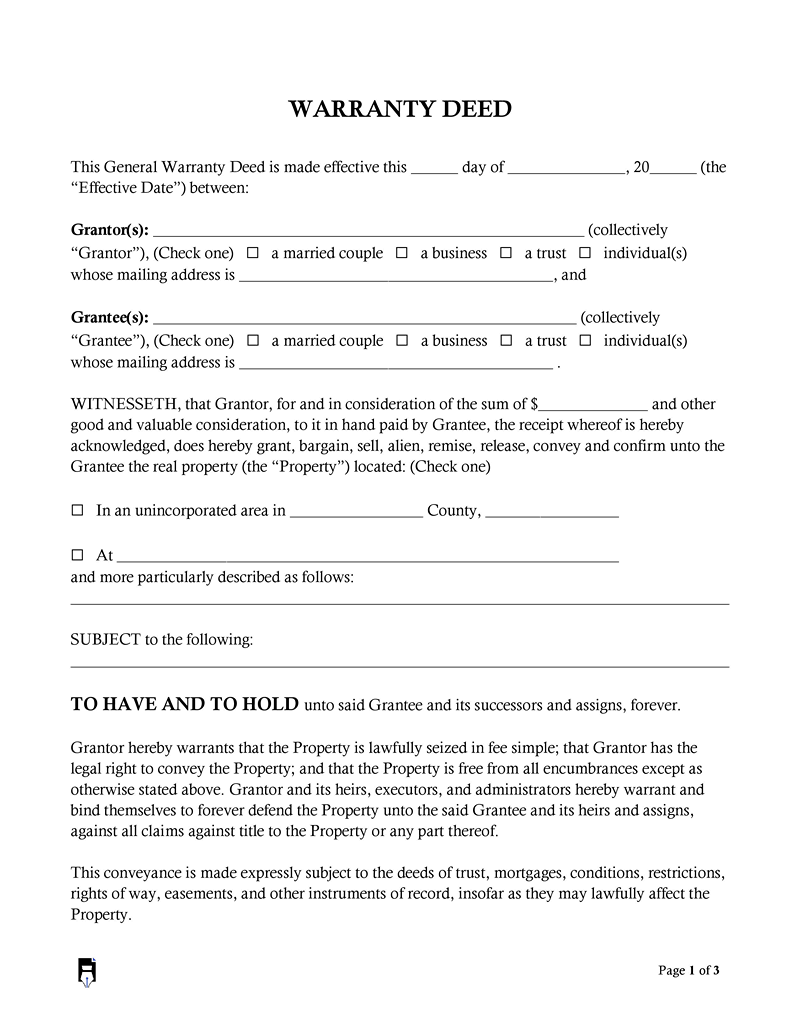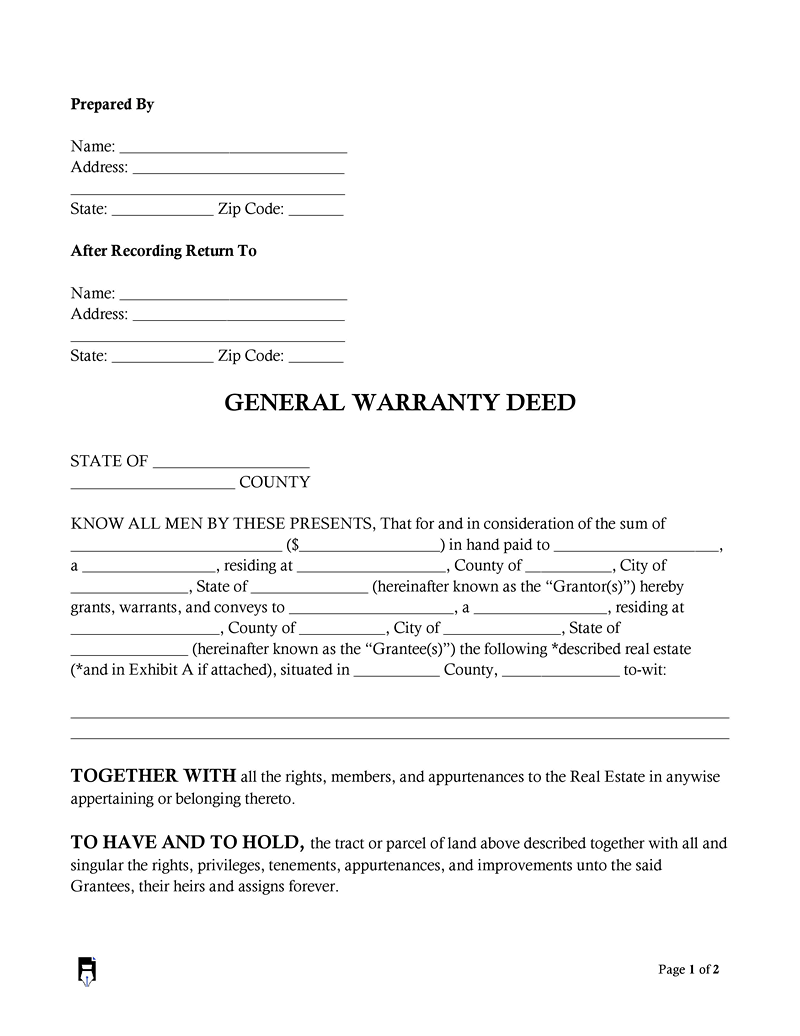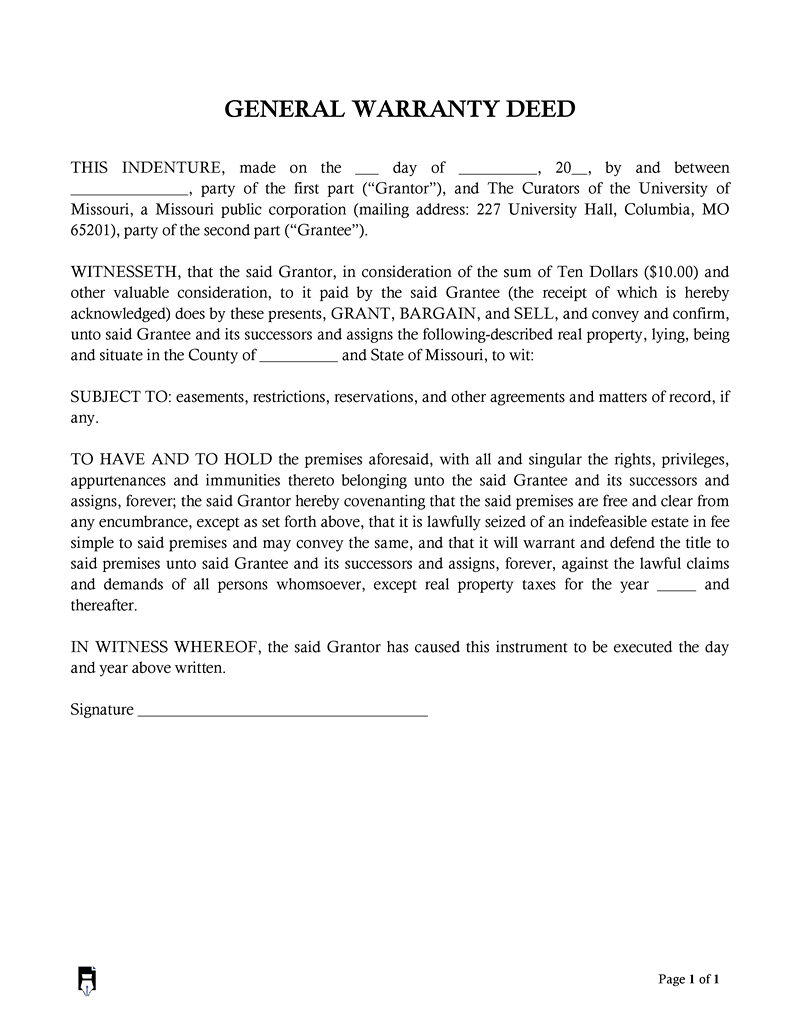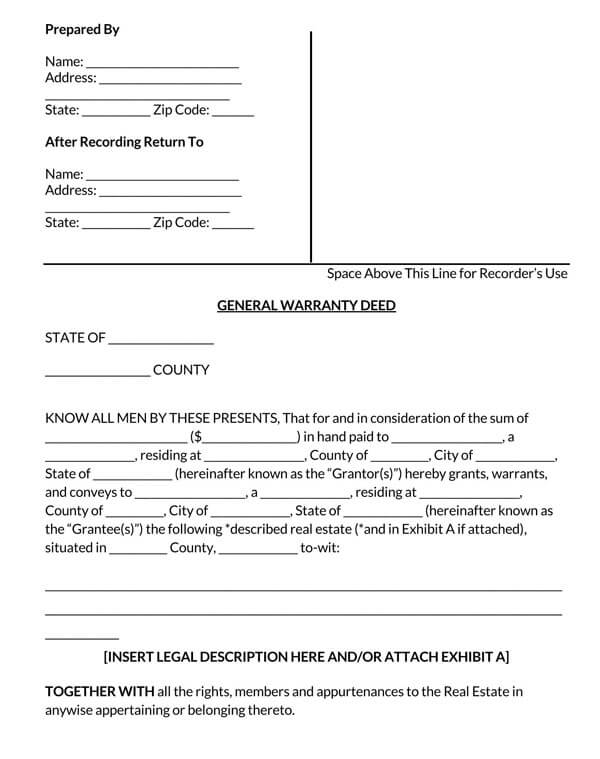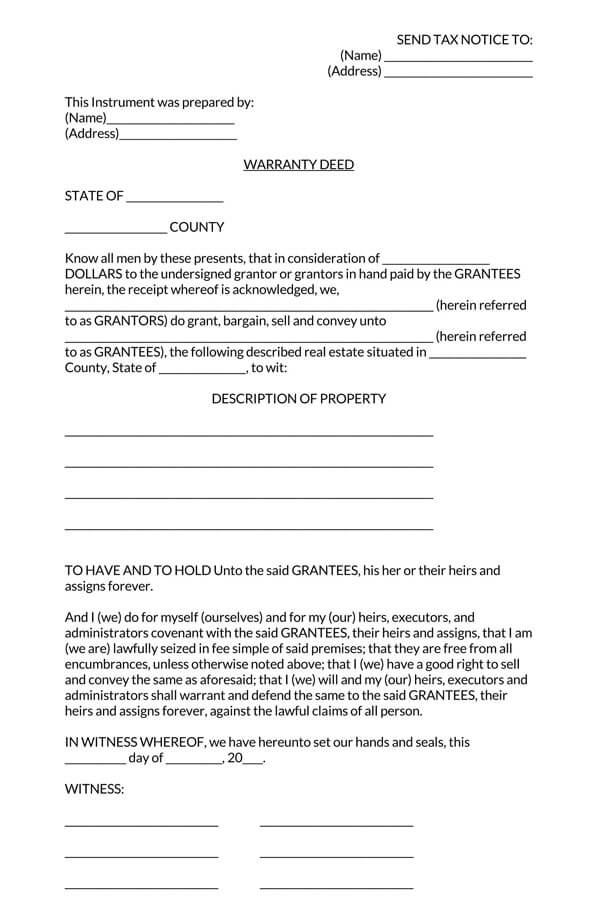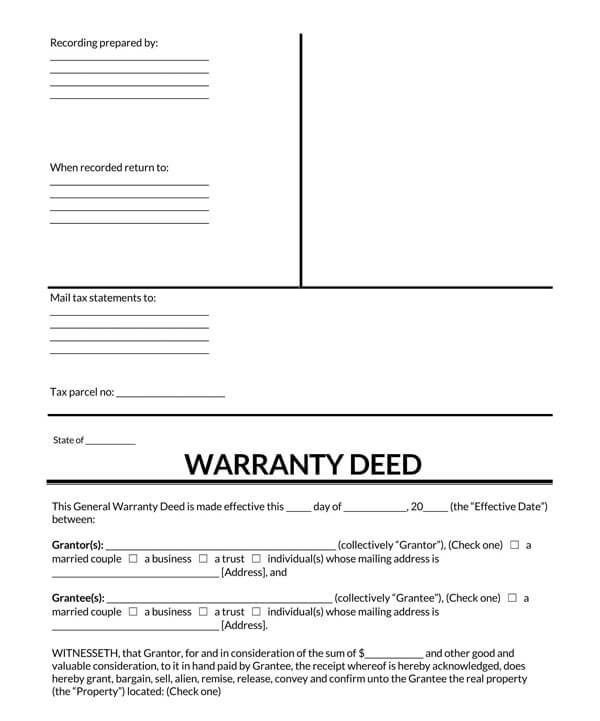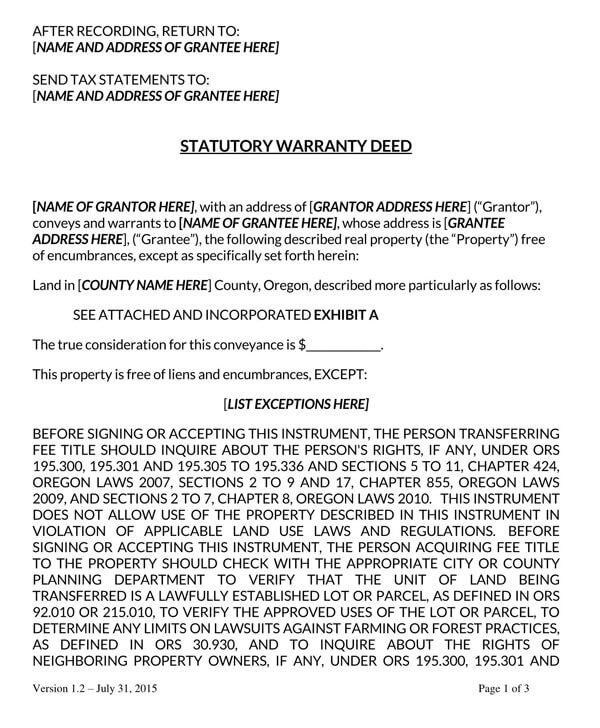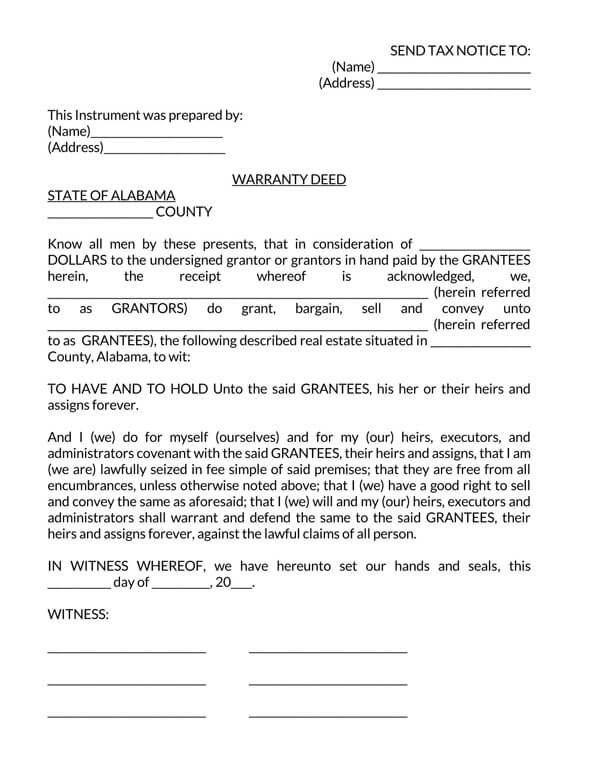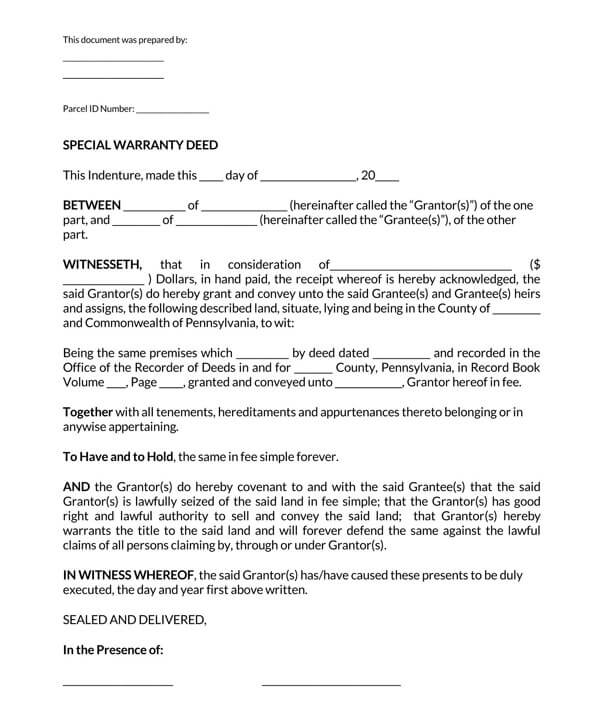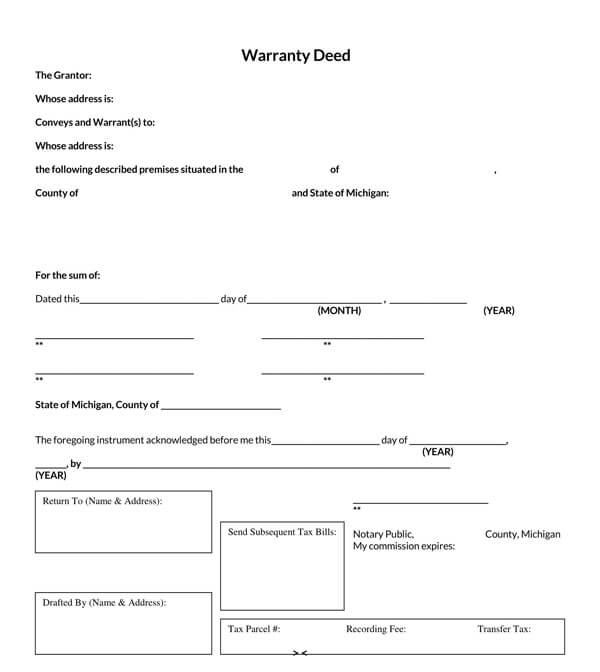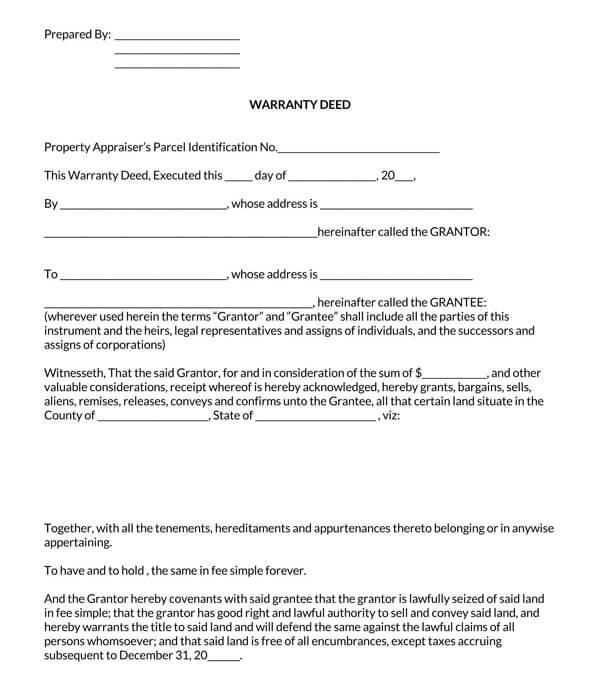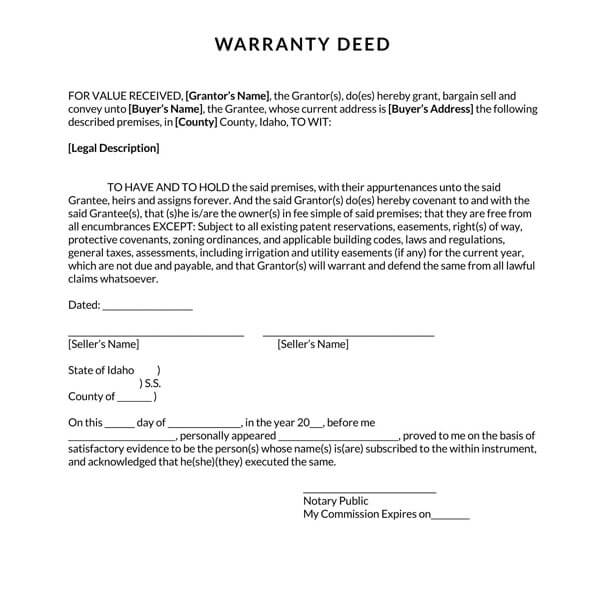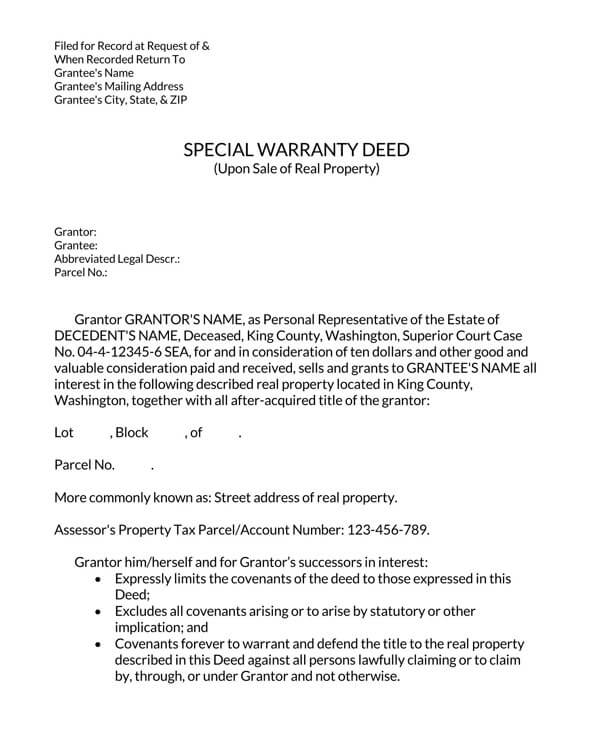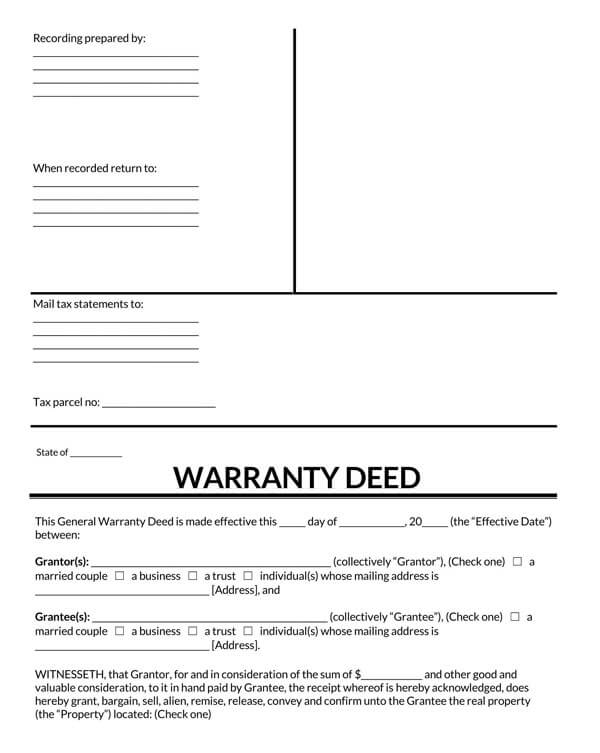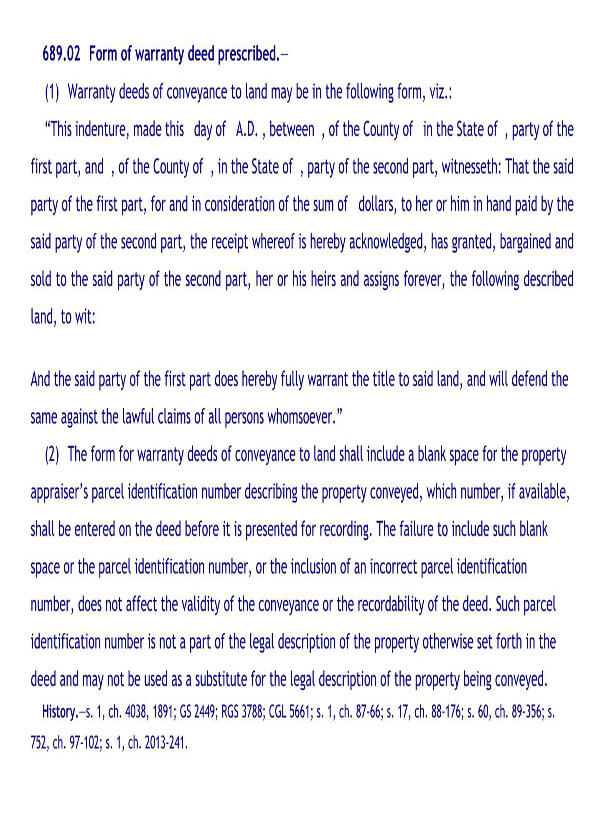A general warranty deed is a legal contract used when you transfer land ownership to a new buyer. Every state has its warranty deed form, and there are many forms of warranty deeds, each with a different level of security for the buyer. When a land transfer occurs, the new owner is identified as the last documented holder of the title, along with a list of all previous owners’ names, purchase price, mortgages, and sale dates. This form of deed ensures ownership by transferring the property in the cleanest way possible. It guarantees that a property’s title is free of others people’s rights, such as liens.
In other terms, you ensure that the property is transparent so that creditors cannot use it as collateral for your debt. Warranty deed forms are used to shield the buyer from possible fraud and financial burdens associated with the property—especially if you, as the seller lack the authority to sell it. The deed typically specifies the terms of the sale, the county in which the sale occurs, a legal description of the property and its borders, the two parties involved in the move, and any covenants made to the new owner and previous owners of the property. It is a document that a buyer may want to receive from you and sign before buying a new home.
A general warranty deed is also known by other similar names.
They are:
- Warranty Deed
- Special Warranty Deed
- Deed of Guarantee
Free Warranty Deed Forms
Get General warranty deed forms templates for free instant download and use them for your sites.
General Templates
By State
Warranty deeds differ by state. Below are some of the states and how warranty deeds apply in them:
Types of Warranty Deed Forms
There are two types of warranty deed forms. General warranty deeds and special warranty deeds. Both offer the same “warranties” that make them a must-have for buyers, but they set slightly different requirements.
In this section, we have explained the two types of warranty deed forms:
Special warranty deed
A special warranty deed has fewer buyer rights than a general warranty deed. This document offers some security to both you and the buyer. Special warranties do this by only making you liable for any covenants and problems with the property that existed while you owned it. It does not cover the entire history of the land, making the buyer liable for any legal claims, debts, or covenants made before the last owner’s tenure.
General warranty deed
The general warranty deed is an all-inclusive insurance package that gives a buyer the highest level of cover in the event of fraud, property problems or claims to interest/title to real estate as stated in the deed. You will take full responsibility for any legal actions taken against the property and any disputes that arise due to the general warranty deed. This includes the entire history of the land, including any problems that occurred before your property ownership. All covenants are your responsibility.
Reasons to Use General Warranty Deed Form
There are various reasons why a general warranty deed form exists.
These reasons include:
- It proves that the grantor is the rightful owner and has a legal right to transfer title.
- It proves that the property is free and clear of outstanding liens, unpaid taxes, easements, etc.
- It proves that the title is clear of defects, such as errors in the public record.
- It acts as an assurance that the grantor guarantees that it will protect title against third parties’ claims.
- It ensures that the grantor will do whatever necessary to make good the grantee’s ownership.
- In case there are multiple owners of the property, the exact claim or portion divided is conveyed clearly and brought to the buyer’s attention
- Any unpaid debts are the responsibility of the seller and not the buyer
Covenants in a General Warranty Deed
Warranty deeds are also known as full covenant deeds because they provide six significant guarantees/covenants that you make to a buyer:
Present covenants
- Covenant of Seisin: You promise the buyer that the deed accurately identifies the land being transferred.
- Covenant of the right to transfer: You guarantee the buyer that you have the legal right to transfer the property.
- Covenant against obstruction: You guarantee the buyer that there are no secret or undisclosed mortgages, covenants, or rights of way that would burden or reduce the value of the land.
Future covenants
- Quiet enjoyment covenant: You agree to protect the buyer’s right to the property against future challenges.
- Warranty Covenant: You agree to protect the buyer’s property from any potential interference disputes.
- Covenant of further guarantees: You promise to correct potential problems with the title.
What to Include in the Deed Form
Just like other legal documents, a warranty deed form has a format to it. In this section, we have elaborated on what you should include in your warranty deed form.
Seller/grantor information
The seller is the person or company that currently owns the property. The heading “Prepared By” will appear in the upper right-hand corner of this document. Generally, through this deed, the seller of the property prepares and submits this document; however, any party can prepare and present this document on your behalf as well (provided that you agree and sign this form). The blank space labeled “Name” will be the first piece of information requested. In this section, enter your full name. There will be two empty lines below this where you will write your mailing address. Finally, write your State and Zip Code.
Buyer/grantee information
The Grantee is the person or company who will become the new owner. Three lines will require your attention. Write the name of the mail recipient on the first line. You will then write their mailing address on the two empty lines below this. Finally, the third line would be for writing the state and zip code for the documented mailing address. After this document is issued and registered, there might be questions on where official correspondence from concerned government departments should be sent. Include these details in the section titled “After Recording Return To.”
Joint tenancy
Warranty deed forms may be used to transfer ownership to a group of new owners known as joint tenants. Each joint tenant owns a portion of the overall property and has the option to sell or distribute their share as they see fit. Locate the line after the words “…and coveys to.” This line has three blank spaces that you should fill in to define the individual (buyer) receiving this property. Write the buyer’s full name, their role /status, and the buyer’s residential address.
Consideration
In this section, write the amount of money that will be paid for the property that you are selling.
Legal information
The legal description, which is usually found on your property deed, enables everyone to determine which piece of property is being transferred. Fill in the county and state where the property is given through this deed is situated. There will be some blank lines where you must include the legal description of the property being transferred. If space is limited, provide the legal description as an attachment that is correctly numbered, signed, and dated.
Parcel number
A parcel number is a number assigned to parcels of real estate by the tax assessor of a particular state for identification and record-keeping purposes. This number is usually written on the property’s tax bill, but if you can’t find it, you can call or visit the city, district, or court office where the property taxes are paid.
Signatures
Each grantor needs to sign his or her name on the line labeled “Grantor Signature.” Below this, your printed name should be presented. Your address must also be reported, and this may be done using the last two blank lines of your signature area (“Address” and “City, State, & Zip”).
Witnesses
Some states require witnesses to be present when the owner signs the deed. Look for the section titled “In Witness Whereof.” There will be enough space here for two witnesses to sign their names. Each witness must sign his or her name, print it, and include his or her address.
Notary public
The last part of this document is set aside for the notary public who will notarize it. Only they can complete this section by providing information such as the venue, signature parties, and date. If the notary has provided these things, they will provide the required credentials and notarization seal for this document to be complete. The person transferring the property should take the deed to a notary public, who will check the authenticity of the signature on the deed.
Liabilities and Title Insurance
Since a warranty deed form gives strong protection to a buyer, the seller is faced with liabilities. A buyer can sue you if issues occur after the transfer of property with a general warranty deed form. Usually, a complete title search is performed by a title company to nullify liabilities. The title search usually goes smoothly, and the property is transferred without problems. However, extra protection is provided in case of anything is missed. Real estate transfer with a mortgage involves title insurance, where insurance is put into action if any disputes arise.
Warranty Deed State Laws
Warranty deeds also vary by law. Below are the various state laws.
- A.L. – § 35-4-271
- A.K. – AS 34.15.030
- AZ – § 33-402
- AR – § 18-12-102
- C.A. – § 1092
- CO – § 38-30-113
- C.T. – Sections 47-36c & 47-36d
- D.E. – § 121
- FL – § 689.02
- GA – § 44-5-62
- H.I. – Chapter 13-16
- I.D. – § 55-612
- IL – 765 ILCS 5/9
- IN – § 32-17-1-2
- I.A. – § 558.19(3)
- K.S. – § 58-2203
- KY – KRS 382.030
- LA – CC 2475
- ME – Title 33, § 763
- MD – § 2-105
- MA – Chapter 183, Section 10
- MI – § 565.151
- MN – § 507.07
- MS – § 89-1-33
- MO – § 442.430
- MT – § 70-20-103
- N.E. – § 76-206
- NV – NRS 111.312
- NH – § 477:27
- N.J. – Section 46:4-7
- N.M. – (§ 47-1-29 & § 47-1-44)
- N.Y. – N.Y. Real Prop L § 258
- NC – § 47H-6
- N.D. – § 47-10-13
- O.H. – § 5302.05
- OK – § 16-40
- OR – ORS 93.850
- PA – 21 P.S. § 5
- R.I. – § 34-11-12
- S.C. – § 27-7-10
- S.D. – § 43-25-5
- T.N. – § 66-5-103
- TX – § 66-5-103
- U.T. – § 57-1-12
- V.T. – § 301
- VA – § 55-68
- W.A. – RCW 64.04.030
- WV – § 36-4-2
- W.I. – § 706.10(5)
- W.Y. – § 34-2-102
Warranty Deed Vs Quitclaim Deed
A warranty deed form guarantees that the title to a property is free of liens, debts, and other rights that others may have. A Quitclaim Deed only specifies the seller’s interest in the property and does not promise that it is free of other people’s interests.
A quitclaim deed is usually used to transfer real estate between known parties, such as family members or partners, where the additional security layer provided by a warranty deed form is not required. For example, if a property owner divorces, they may use a Quitclaim deed to erase their former spouse’s name from the property title and replace it with the new spouse’s name (if applicable).
Warranty Deed Vs Deed of Trust
A warranty deed form guarantees that a property’s title is free of any rights held by others at the time of sale. A Deed of Trust guarantees neutrality between a lender and a borrower by including a neutral third party, known as a trustee, in the transaction (usually a separate legal entity like a title company). A lender lends a borrower money in a Deed of Trust agreement to buy a house. On the other hand, a Deed of Trust transfers possession of the legal title to the property to a neutral trustee before the borrower fully repays the loan.
Conclusion
A general warranty deed form is a document used when transferring property from the existing owner (grantor) to one or more new owners (grantees). You guarantee the new owner against all title disputes by signing the warranty deed form, regardless of when they occurred. This guarantee is not limited to your ownership of the land. Even if the title problem was created by someone who owned the property before you, you are still legally liable.
